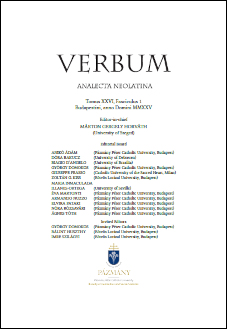Morfosintassi, semantica, concettualizzazione: costanti e varianti nell’uso dell’articolo definito
Megjelent 2025-07-10
Kulcsszavak
- articolo,
- articolo definito,
- definitezza,
- descrizioni definite,
- articolo espletivo,
- individuazione
Hogyan kell idézni
Copyright (c) 2025 Paolo Acquaviva

This work is licensed under a Creative Commons Attribution 4.0 International License.
Absztrakt
Tradizionalmente si identifica l’articolo definito con l’espressione linguistica di una descrizione definita. Nei sistemi grammaticali come quelli delle lingue europee occidentali, l’unica variazione starebbe nell’uso o assenza dell’articolo (water / l’acqua ). Questa impostazione semplicistica ha portato a ignorare tutta una serie di altri usi dell’articolo, conosciuti ma considerati irrilevanti. Questo studio passa in rassegna sistematica questo spazio di variazione. L’interpretazione come descrizioni definite e come generici è il suo nucleo centrale, in cui la variazione dipende deterministicamente dalla denotazione del nominale e dalla morfosintassi della lingua. Ma la funzione di individuazione del referente nel contesto pragmatico e enciclopedico sottende altri usi dell’articolo. Questi delineano uno spazio di variazione più ampio, che sembra arbitrario solo per la rilevanza di fattori comunicativi e non strettamente grammaticali. diventi parte della norma linguistica accettata.
Hivatkozások
- Aguilar-Guevara, Ana & Joosts Zwarts (2010): Weak definites refer to Kinds. In N. Li & D. Lutz (eds.) Proceedings of SALT 20. 179–196. https://doi.org/10.3765/salt.v20i0.2583%20
- Ashdowne, Richard (2004): Re(de)fining address: an overlooked French phenomenon. In Oxford University Working Papers in Linguistics, Philology and Phonetics 9: 1–36.
- Elbourne, Paul (2013): Definite Descriptions. Oxford: Oxford University Press.
- Frege, Gottlob Wilhelm (1892): Über Sinn und Bedeutung. Zeitschrift für Philosophie und philosophische Kritik 100: 25–50.
- Gallmann, Peter (2004): Kategoriell Komplexe Wortformen. Berlin: De Gruyter.
- Giusti, Giuliana (2015): Nominal Syntax at the Interfaces. Newcastle upon Tyne: Cambridge Scholars Publishing.
- Haspelmath, Martin (2001): The European linguistic area: Standard Average European. In Haspelmath, M, E. König, W. Oesterreicher, & W. Raible (eds.) Language Typology and Language Universals, vol. 2. Berlin: De Gruyter. 1492–1510. https://doi.org/10.1515%2F9783110194265-044
- Heim, Irene (1991): Artikel und Definitheit. In A. von Stechow & D. Wunderlich (eds.) Semantik / Semantics: Ein internationales Handbuch zeitgenössischer Forschung. Berlin - New York: De Gruyter Mouton. 487–535 https://doi.org/10.1515/9783110126969.7.487
- Heim, Irene (1982): The semantics of definite and indefinite noun phrases. Doctoral dissertation. Cambridge, MA: MIT.
- Jaspers, Karl (1998)[1953]: Einführung in die Philosophie. Piper: München - Zürich.
- Krifka, Manfred, Francis-Jeffry Pelletier, Gregory Carlson, Alice ter Meulen, Gennaro Chierchia, Goderad Link (1995): Genericity: An introduction. In G. Carlson & F.-J. Pelletier (eds.) The Generic Book. Chicago and London: The University of Chicago Press. 1–124.
- Laca, Brenda (1990): Generic objects: Some more pieces of the puzzle. Lingua 81: 25–46.
- Löbner, Sebastian (1985): Definites. Journal of Semantics 4: 279–326. https://doi.org/10.1093/jos/4.4.279
- Mathieu, Éric (2009): From Local Blocking to Cyclic Agree: The role and meaning of determiners in the history of French. In J. Ghomeshi, I. Paul, and M. Wiltschko (eds.) Determiners: Universals and Variation. Amsterdam: John Benjamins. https://doi.org/10.1075/la.147.04mat
- Rabern, Brian (2015): Descriptions which have grown capital letters. Mind and Language 30: 292–319. https://doi.org/10.1111/mila.12081
- Russell, Bertrand (1905): On denoting. Mind 14: 479–493.
- Strawson, Peter (1950): On referring. Mind 59: 320–344.
- Zamparelli, Roberto (2002): Definite and bare kind-denoting nouns phrases. In F. Drijkoningen, C. Beyssade, P. Monachesi and R. Bok-Bennema (eds) Romance languages and linguistic theory 2000. Amsterdam/Philadelphia: John Benjamins. https://doi.org/10.1075/cilt.232.17zam

